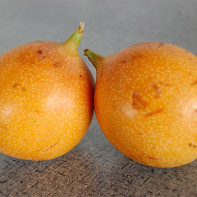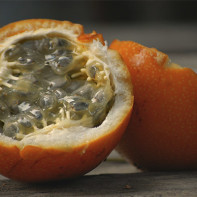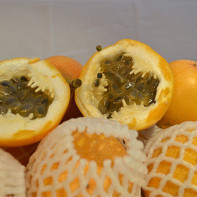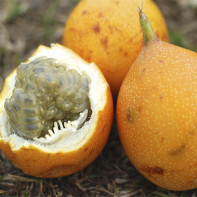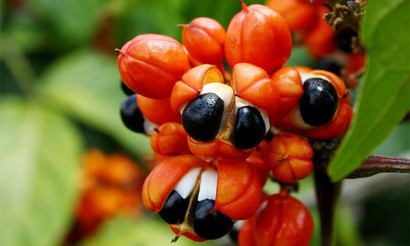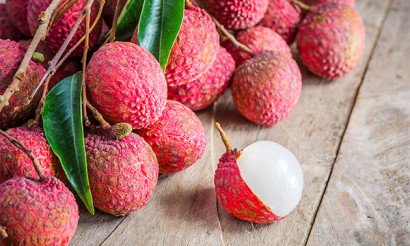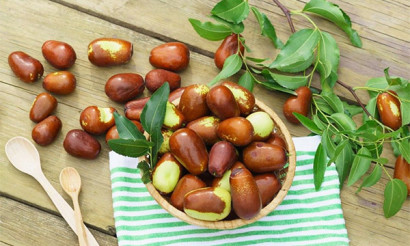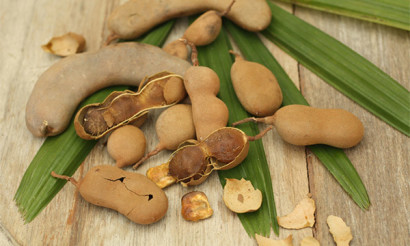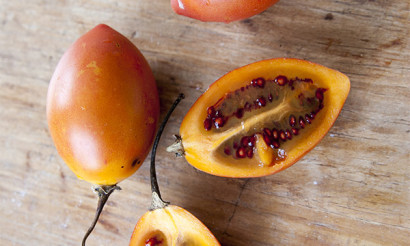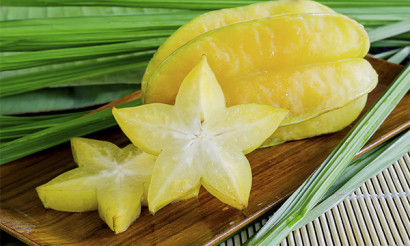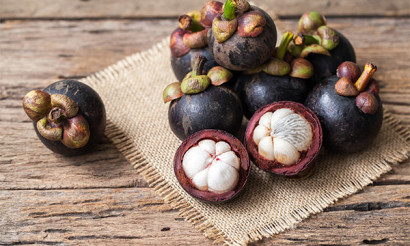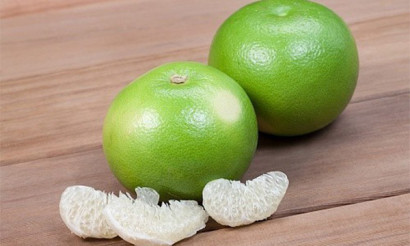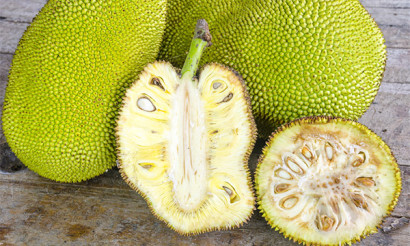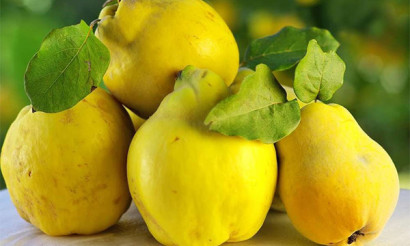Granadilla fruit: benefits and harms to the body
Granadilla is a tropical fruit popular in many warm countries.
- What is granadilla
- What does it look like
- Views
- Where grows
- How is granadilla different from passion fruit
- Composition and calorie content
- Health Benefits of Granadilla Fruit
- For women
- For men
- During pregnancy
- When breastfeeding
- For children
- When losing weight
- Harm and contraindications
- How to choose and store
- How to eat granadilla
- How to clean granadilla
- Is it possible to eat a bone
- Cooking use
- Spring Exotic Salad
- Granadilla Sweet Meat Sauce
- Granadilla Fruit Mousse
- Curd casserole "Exotic"
- Tropical Midday Pudding
- Interesting Facts
What is granadilla
The fruits of granadilla refresh quite well on a hot afternoon. The fruit has many useful properties for the body, it is often used in cooking and used in the cosmetics industry. Granadilla is considered one of the most delicious fruits on the planet. Its homeland is called the expanses of South America.
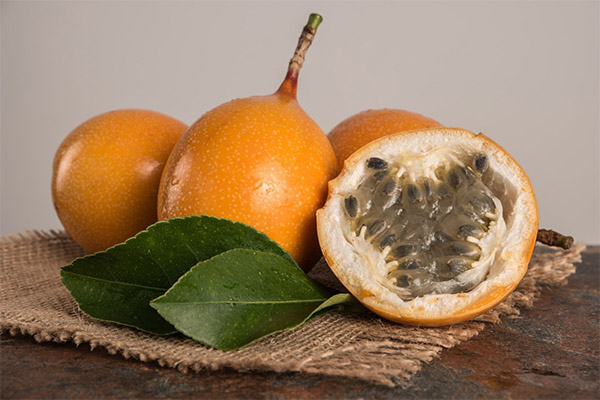
What does it look like
Granadilla is an evergreen plant from the genus Passiflora, belongs to the Passionflower family. It is a tree-like tropical liana, which can grow up to 10 m high. The flowers attract with their exotic appearance: the petals are large in shape and painted in a purple-white hue, light mustache plants and large green stamen threads with pollen grains are visible inside the buds. The flower looks very exotic and has a unique aroma.
There are several types of granadilla in the world. The most famous species of this tropical plant are yellow and edible. Depending on the type of fruit can have a spherical or oblong shape, be the size of a large peach fruit, or resemble a not very large melon. Weight usually reaches 150-200 g. The peel has a large gamut of colors, depending on the species: from light green, yellow and orange to purple and violet. Under the skin is a white layer, and inside there is a fragrant pulp with dark seeds in a jelly-like shell.
Views
- The giant granadilla has an oval-shaped fruit. Its length is 10-30 cm and a width of about 8-12 cm. The skin is thin, has a yellowish or greenish surface color. The pulp is white or pink, inside there are large brown and purple seeds.
- Granadilla blue is a tropical fruit with a characteristic yellow color; its fruits are oval. Their length is 6 cm, diameter about 4 cm. If you cut the fruit in half, inside you can see the grains of red.
- Granadilla banana has an unusual oval shape. The length of the fruit is 12 cm, the width reaches 4 cm. It has a slightly pale yellow or dark green color, with a sweet orange core and black seeds inside the pulp.
- Edible Granadilla is well known to tourists under a different name - passion fruit. The tropical fruit has a round, sometimes oval shape. Size can reach 40–80 mm in diameter. Inside is a juicy pulp with lots of seeds. The color may have a characteristic violet, red or purple color. Passion fruit is often confused with its relative - granadilla yellow.
- Granadilla yellow is widely used in cooking. It has a distinctive shape, a bit like an egg. Fruits can grow up to 6-7 cm in diameter. The skin is slippery to the touch and may have a special yellow, orange and even reddish tint. In ripe fruit, the skin is covered with small black spots. Inside, the fruit has a clear flesh with small black flat seeds. These seeds are located throughout the pulp, so it is not easy to get them. However, they are soft in their consistency and are considered edible. You can eat sweet fruit directly with the seeds, you do not need to remove them. The pulp has a characteristic jelly-like consistency and an intense sweet taste. The taste of exotic fruit is quite diverse.Granadilla combines the sour notes of kiwi, the sweet aftertaste of strawberries, the aroma of ripe melon and gooseberries.
Where grows
The place of growth of this tropical plant is called a country with a hot climate. For the first time this exotic fruit was found by the Spanish conquerors conquistadors, who sailed to America in search of new territories. Today, you can find the fruits of granadilla in the wild in Mexico, it is successfully cultivated in the hot expanses of Bolivia, in Brazil, in Argentina, in Paraguay and in many other countries. Granadilla also grows on the vast islands in the Caribbean - Hawaii, Jamaica, Haiti and Guam.
A heat-loving plant has also been repeatedly tried to cultivate in European countries and even in the Krasnodar Territory in Russia. However, it is not possible to obtain the reference rich taste of granadilla in colder climatic conditions, while the plant produces a crop only once a year.
How is granadilla different from passion fruit
Granadilla and passion fruit are representatives of the same family - Passion flowers. At the same time, passion fruit is considered a more common plant variety of this species. Despite the fact that the appearance of these fruits is completely different, many tourists very often cannot distinguish between these two fruits from each other. In order not to confuse these fruits, it is necessary to highlight their main distinguishing features:
- In passion fruit, the peel has a dark purple color, has the characteristic “wrinkles”, and in granadilla it has a rich yellow-orange hue.
- In the ripe fruits of granadilla, the tail does not fall off, and in the passion fruit the stalk often comes off the fruit.
- In passion fruit, the flesh has a more saturated color.
- Both fruits have a white layer that separates the peel and pulp of the fruit, but in passion fruit this layer is thinner.
- Fruits have completely different tastes, while the fruits of granadilla are considered much sweeter.
- Passion fruit seeds are much harder, granadilla seeds are soft, they are much easier to chew.
- Passion fruit is much smaller in shape than its yellow cousin.
Composition and calorie content
Granadilla has a very high taste. However, this tropical fruit gained its popularity not only because of its sweet pulp. The fact is that the fruit has a fairly low nutritional value, while the fruit contains many useful elements. 100 g of granadilla contains about 46 kcal. At the same time, 80.2 g is water and 10.4 g is dietary fiber. In the fetus, there are only 0.1 g of fat, 8 g of carbohydrates, 0.5 g of protein.
Granadilla is considered a fruit that is good for health due to the concentration of many useful elements and vitamins in it. The fruits contain a lot of healthy iron. In 100 g, there are about 1600 micrograms of iron, due to which the fruits of a tropical plant are considered indispensable in the treatment of anemia.
In addition, granadilla contains an abundance of zinc, potassium, and copper. These microelements help patients with high blood pressure, eliminate high puffiness and contribute to the treatment of other cardiovascular pathologies. Potassium in the composition of granadilla contributes to the positive work of the heart and blood vessels, affects the proper functioning of the urinary system, the functioning of the nervous and muscle tissue in the body. Phosphorus helps strengthen human bone tissue, produce ATP acid, which is the main energy carrier.
Granadilla fruits also contain elements necessary for the body, such as sodium, selenium, magnesium and B vitamins. They play an important role in the proper functioning of the body's metabolic processes, contribute to the creation of blood cells, help to produce antibodies and affect the development of the reproductive and endocrine system.
Due to the vitamin C contained in these tropical fruits, the necessary collagen is produced in the human body, hormones are stimulated, histamine is neutralized, and red blood cells are produced. This vitamin has a positive effect on the human immune system and helps fight colds.
Health Benefits of Granadilla Fruit
This tropical fruit has a complete composition of all the necessary vitamins and minerals that strengthen the human body, promote bone growth, relieve insomnia and eliminate headaches.

For women
The substances contained in the tropical fruit - vitamins, hydroxyacids and antioxidants - contribute to better hair and nail growth in women. That is why tropical fruit is often used in the cosmetics industry: it is added to shower gels, hair shampoos, lotions and creams for the body and face.
Creams and lotions made on the basis of granadilla help fight skin problems, give it an elastic look and freshness, create a lifting effect. Useful vitamins and minerals in the fetus fight skin irritation, cleanse, soothe and heal problem areas of the body. They help fight the manifestation of dermatitis, psoriasis, rid the skin of dryness and rashes.
Especially beneficial are the fruits of granadilla affecting the female body with problems with insomnia and frequent depression. Exotic fruit can help get rid of frequent migraines and restore healthy sleep. Indeed, the composition contains essential oils that have a sedative effect, relieve neurosis and anxiety.
For men
Thanks to its wide vitamin and mineral complex, granadilla maintains the overall tone of the entire body in men. The beneficial substances in the fruit help to recover quickly, for example, after physical exertion or training in the gym.
The fruits of granadilla also contain vitamin B9, which is so necessary for men for the proper functioning of the genitourinary system. It helps maintain sperm viability. In addition, the vitamin normalizes all processes in the body, including the proper functioning of the bone marrow, protects against the appearance of a tumor.
During pregnancy
The fruits of granadilla during pregnancy saturate the body of a woman with all the useful vitamins and minerals. Fruits can be added to yogurt, cottage cheese, make fruit salads or smoothies from them. In addition, the tropical fruit contains the folic acid necessary for expectant mothers, which contributes to the proper development of the fetus.
In this case, it is best to consult with a personal gynecologist on this issue. Women should eat fruits only after the approval of a specialist due to the fact that granadilla seeds have the effect of drowsiness. With frequent consumption of fruit, the expectant mother may feel severe fatigue and drowsiness. Despite all its beneficial properties and vitamins, in some cases, the use of granadilla can also cause allergic reactions in the body and adversely affect the development of the fetus.
When breastfeeding
During the period of breastfeeding, it is better for newly minted mothers to give up eating exotic fruit for a short time. At least in the first three months you should not use granadilla, since there is a risk of severe gas formation in the child or the development of allergies.
For children
Due to the risk of an allergic reaction, an exotic fruit should not be offered to children under three years of age. The fruits of granadilla can provoke an allergy in the fragile body of the child and cause side effects in the digestive tract. At the same time, vitamin B (riboflavin) contained in the fruits of the plant is considered the main building component of the body and is necessary for the proper growth and development of the child. And vitamin B6 contributes to the formation of proteins and the proper functioning of the metabolic processes of the whole child’s body.
When losing weight
Due to the fact that the fruits of granadilla are classified as low-calorie foods, they can be eaten in case of problems with obesity. The high content in exotic fruits helps to eliminate toxins and cleanse the body. Thanks to the large vitamin complex, granadilla is useful for people who are actively involved in sports and want to maintain their body in excellent physical shape.
Granadilla is considered a low-calorie product with a large amount of nutrients. Therefore, food and drinks with its addition are perfect for people who want to lose weight and take care of their health.
Harm and contraindications
With caution, tropical fruit should be consumed by people who have an individual intolerance to the product or a tendency to allergies. At the same time, there are practically no special restrictions on the use of granadilla fruits.
However, this fruit should be carefully eaten by patients who suffer from diabetes. It is also important not to overdo the use of fruit for people who are prone to gain weight. Although granadilla is considered a low-calorie product, the fruits still contain a high concentration of fructose. And this can lead to a jump in blood sugar, resulting in increased hunger.
In addition, the exotic fetus has a diuretic and laxative effect. That is why you should not abuse the fruit too much, especially for those patients who are prone to diarrhea.
How to choose and store
In a tropical climate, granadilla usually bears fruit twice a year. Therefore, in warm countries, crops can be harvested several times. A plentiful fruit crop is harvested after the end of the rainy season. This should be taken into account by tourists who buy exotic fruits during their trip abroad.
Today you can find granadilla on the shelves of almost all major supermarkets in the world. At the same time, exotic fruit is exported to other countries almost year-round. However, fruits brought from afar may not have all the taste and beneficial properties. The fact is that it is impossible to bring ripe granadilla fruits without damage and spoilage. So that the exotic fruit retains its freshness and beautiful appearance for as long as possible, the peel is subjected to chemical treatment. Therefore, it is not recommended to use the skin of exotic fruits brought from afar to supermarkets.
When choosing granadilla, it is important to remember that its fruits are perishable. And the approximate shelf life of fruits is only a week at room temperature. At the time of purchase, you need to pay special attention to the condition of the peel. The skin of the fetus should be smooth and firm to the touch. Ripe fruit is usually covered with small black spots on the surface of the skin. Its weight is approximately 200 g. If a granadilla without characteristic dark spots or very soft is accidentally caught in the store, such fruit should not be bought.
How to eat granadilla
Exotic fruit is good to eat fresh. By its taste, granadilla has a sweet, slightly watery aftertaste. In this case, the jelly-like pulp with seeds inside is very similar to the taste of gooseberries or melons. The most acidic varieties of granadilla can be combined with sugar or honey, and the sweet ones are prepared with salt and pepper as a snack.
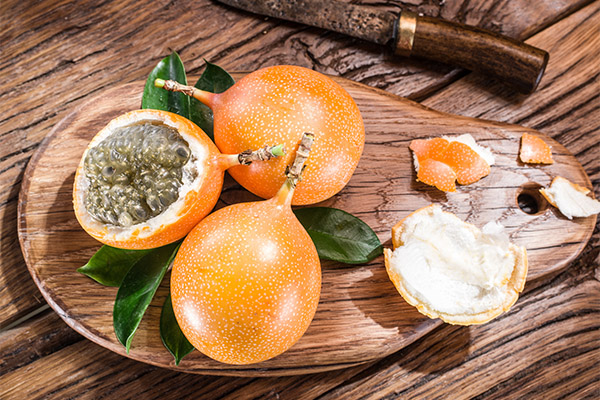
Granadilla fruits go well with fresh salads and as appetizers, the fruit is added to desserts, made from it casseroles, puddings and freshly squeezed juices are prepared.
How to clean granadilla
Peeling the fruits is easy enough. To do this, you need to take a sharp knife, carefully divide the fruit into two halves, making an oblong incision 5 mm deep.The pulp and seeds of the fruit are edible, they are conveniently removed with a teaspoon. The core of the fruit does not need to be separated from the seeds. Granadilla seeds are quite soft, easy to chew, do not cause digestive discomfort.
Is it possible to eat a bone
There are a lot of small seeds in the fruits of granadilla, they practically do not separate from the pulp. Despite their large number, they are almost invisible while eating fruit. Granadilla seeds are very delicate, soft and fragrant. They are considered edible, so the seeds are not removed from the fruit before cooking or eating raw.
Cooking use
Usually in cooking, granadilla is used fresh. Local aborigines consume this fruit without subjecting it to heat treatment, and simply eat the pulp with a spoon.
In world cooking, the fruits of granadilla are more widely used. Due to the exotic sweet and sour taste, they are used as an additive to meat and fish dishes. The pulp of unripe fruits is stewed separately, as well as in combination with other vegetables.
Fresh juices, syrups, tinctures, and liquors are made from the pulp of the fruit, add it as the basis for alcoholic and non-alcoholic cocktails. Granadilla blends wonderfully with other fresh juices, such as orange, kiwi or mango.
Due to its natural jelly-like consistency, the fruit is excellent for making jelly, preserves, desserts, sweet salads, as well as a filling for puddings and pastries. Due to its high sugar content, fruit is added to bakery and confectionery products. And thanks to its amazing aroma and taste, granadilla is also used as a natural flavoring agent based on yoghurts and sweet sauces.
Spring Exotic Salad
Dish ingredients:
- 1 ripe granadilla fruit;
- 10 fruits of strawberries;
- a mixture of salads;
- 1 white turnip;
- 1 bunch of green onions;
- pumpkin seeds for decoration;
- Parmesan for decoration;
- sugar, balsamic vinegar and sesame oil for dressing to taste.
Spread lettuce leaves on a plate, turnip cut into slices, strawberries into cubes, chop green onions and spread on a plate. Cut the fruit of granadilla in half and get the sweet pulp for the salad. Mix the sauce in a separate bowl. Add a balsamic bite, sesame oil, sugar and mix well. Season salad with sauce. Before serving, decorate the salad with pumpkin seeds and grated parmesan.
Granadilla Sweet Meat Sauce
Dish ingredients:
- 80 ml of tropical juice (pineapple, multivitamin or mango);
- 1 chili pepper
- 1 ripe granadilla;
- 2 tsp Sahara;
- 1 tsp starch;
- 1 tsp cold water.
Pour tropical juice from tetrapack into the pan. Finely chop the chilli and add to the juice. To make the pepper less spicy, remove the seeds or put it in the sauce. Cut the fruit of one ripe granadilla and get the sweet pulp. We put a saucepan with juice on a small fire, pour sugar, stir. We breed starch in 1 tsp. cold water. After boiling the liquid in the pan, reduce the heat on the stove, add the pulp of granadilla, stir. Pour the starch diluted in water into a saucepan in a thin stream. Stir constantly. The sauce should become thick, after which we remove the pan from the heat. This spicy spicy sauce with a sweet taste will be an excellent addition to pork meat dishes.
Granadilla Fruit Mousse
Dish ingredients:
- 2 fruits of ripe granadilla;
- 3 ripe bananas;
- 25 g butter;
- 1 large kiwi
- 0.5 cups cream with a fat content of 22–33%;
- 35 g of granulated sugar;
- 1/3 of the juice of a small lemon.
Peel and knead the fruits of bananas with a fork. In a water bath we heat a piece of butter and pour into a chopped banana puree. We clean the fruits of granadilla, remove the soft core.Mix granadilla and crushed banana thoroughly until smooth. Puree the mashed potatoes in the refrigerator for thickening. Peel the kiwi, grind it and add lemon juice. Next, whip the cream with sugar until a thick homogeneous mass. In the puree of bananas and granadilla fruits, add whipped cream. We take a beautiful container for serving. We put in it chopped kiwi, then a mashed mass of bananas and granadilla. Fruits do not mix. We cool in the refrigerator for a couple of hours to thicken before serving.
Curd casserole "Exotic"
Dish ingredients:
- 2 fruits of ripe granadilla;
- 2 tbsp butter;
- 450-500 g of cottage cheese (9% fat content);
- 80 g of granulated sugar;
- 1 chicken egg;
- 1.5 tbsp starch.
We clean the fruits of granadilla, remove the soft core, squeeze the juice from the fruit and add the starch. Drive the egg into the cottage cheese, pour the sugar, mix everything thoroughly. Mix cottage cheese with squeezed juice with starch. The resulting curd mass is laid out in a baking dish. Pre-grease the form with butter. Bake cottage cheese casserole in the oven for about half an hour at a temperature of 180-190 degrees. After cooking, cool the casserole and put in the refrigerator for several hours before serving. Cottage cheese can be decorated with whipped cream and pulp of fruit.
Tropical Midday Pudding
Dish ingredients:
- 3 fruits of ripe granadilla;
- 2 ripe limes;
- 120 g of brown sugar;
- 60 g of flour;
- 60 g butter;
- 2 chicken eggs;
- 0.5 cups of milk;
- 1 tsp baking powder.
Separate the yolks from the proteins in the chicken eggs. Beat the yolks with 60 g of brown sugar. Then we introduce soft butter into the yolks and alter until smooth. Add the flour and mix well. Washing fruits under water. Rub the zest of lime, squeeze the juice from the remaining fruit. Then we get the flesh of granadilla. Beat the egg whites with the remaining brown sugar. Little by little we introduce lime juice and all remaining ingredients. Preheat the oven to 180-190 degrees and bake the pudding until golden brown. When serving, decorate each piece of pudding with a spoon of sweet pulp of granadilla.
Interesting Facts
More than 500 species of granadilla are known in the world. It is for this reason that many different names are attached to the plant. Tourists often call this fruit a passionflower, passionflower and even passion fruit. However, the name granadilla has the most authentic roots, since it comes from the Spanish dialect. As you know, it was the Spanish conquistadors who first introduced this tropical fruit to the Old World.

Some also believe that the name granadilla has French roots and translates as "pomegranate" or grenadille. This fruit could deserve its name due to the large abundance of seeds inside the pulp, which makes it associatively similar to pomegranate.
However, the name “passionflower” can be considered the most interesting name for this fruit. This name is closely related to the English phrase passionfruit, which means “passion fruit”. This name is firmly entrenched in the tropical fruit for one simple reason, many tourists consider granadilla an aphrodisiac. However, this opinion is erroneous. In fact, the plant does not have such medical properties at all. And such an unusual name is more associated with religious interpretation - the crucifixion of Christ and his sufferings. Therefore, the word “passion” in the title has nothing to do with the word “attraction”. On the contrary, it must be interpreted as the "suffering" of Christ.
This theory was put forward in 1610 by the Italian and historical figure Giacomo Bosio. The historian and faithful representative of the church was convinced that the tropical plant embodies the sufferings of Christ. The outer and inner parts of the flower crown represented the crown of thorns of Jesus, the pestles symbolized the nails with which the Savior arrived at the cross.The pointed leaves of the plant resembled a spear piercing the body, and the glands located inside the petiole personified silverfish obtained by Judas.
«Important: all information on the site is provided exclusively in fact-finding purposes. Before applying any recommendations, consult with a profile specialist. Neither the editors nor the authors are liable for any possible harm caused materials. "

